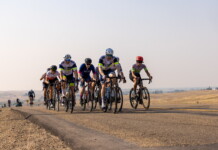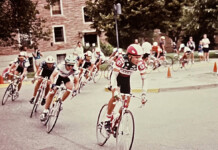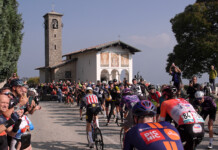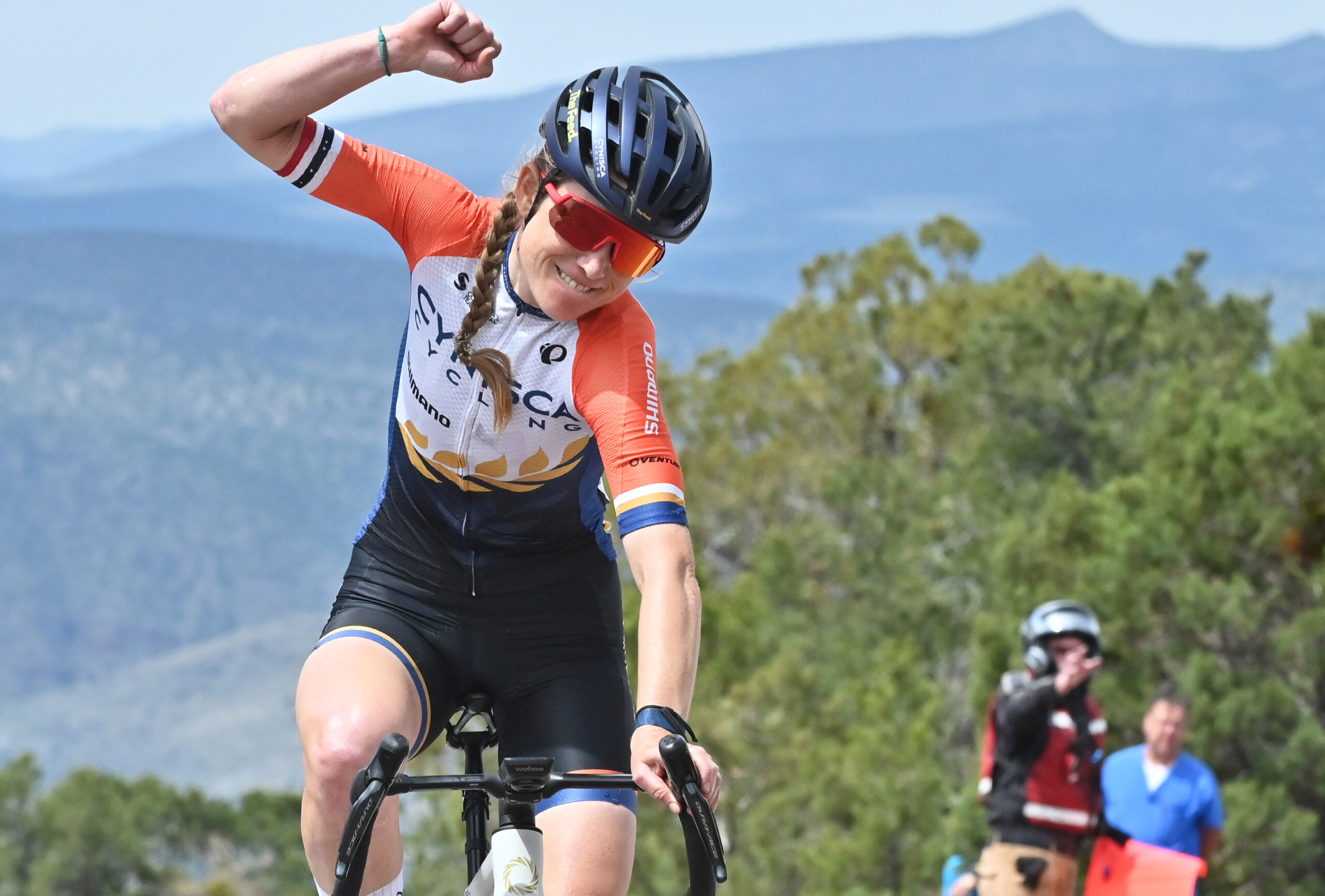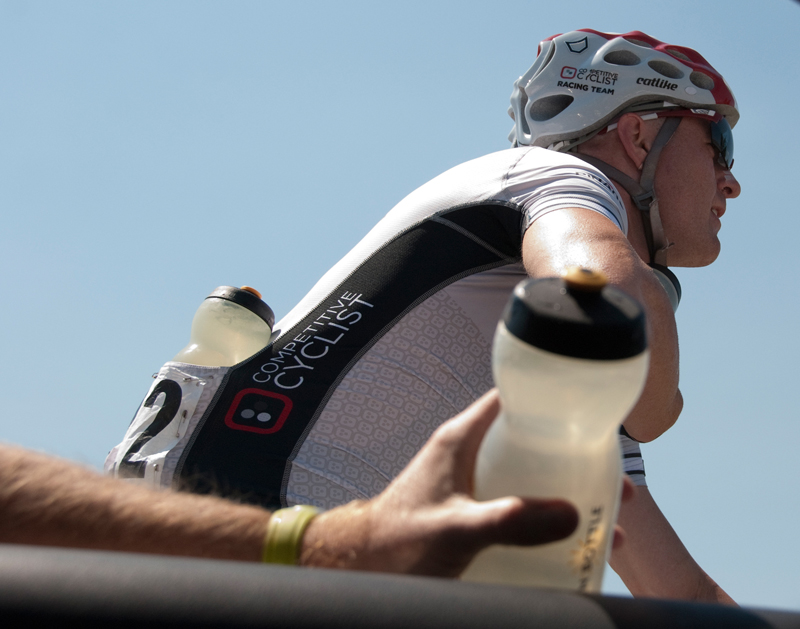
“Boring boring boring … Chaos! Chaos! Chaos!”
This was how Competitive Cycling Racing Team director Gord Fraser described what can be a typical day in team car behind the professional peloton; especially on a long, hot, hilly day, like the first stage of the 2012 Larry H. Miller Tour of Utah, presented by Zion’s Bank.
The stage started (and ultimately finished) on Ogden’s Historic 25th Street, before embarking on a 131.7 journey through Weber and Morgan Counties, taking in 5 major climbs (although only 4 were classified for the King of the Mountains competition) totaling 8,939 feet of vertical ascent.
The field only remained together for about 10 miles, before the first break of the day took off, including Ben Jacques-Maynes (Bissell Pro Cycling), David Williams (Competitive Cyclist Racing Team), Caleb Fairly (Spidertech p/b C10) and Eduard Beltran (EPM-UNE), who were joined by William Clarke (Champion Systems) after the first KOM on Trapper’s Loop.
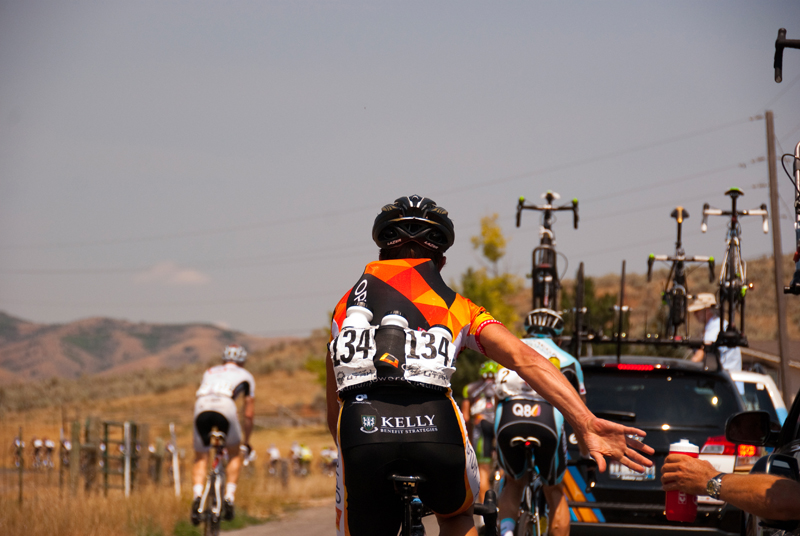
Gord sent the second team car up to the break, while we remained behind the, judging from the number of riders taking multiple “natural breaks”, very well-hydrated peloton. As predicted, things were pretty uneventful until shortly before feeding was opened when Taylor Sheldon got a rear flat towards the bottom of the Trapper’s Loop descent into Morgan Country, changed in about 13 seconds by Competitive Cycling’s mechanic Doug.
This flat turned out to be timely because almost immediately after the road flattened out, the commissaires opened up feeding from the team car. Since Taylor was still negotiating his way through the caravan to rejoin the peloton, Gord took the opportunity to load him up with bottles.
I definitely noticed some movement amongst the various team cars in the caravan, but I was little prepared for the careening that was to come … but more on that later.
I raced for a couple of years in the 1990s; but quite frankly, I sucked. Never really developed great pack skills, never developed any speed. At one point, I had great endurance … I could ride for 8 hours, as long as I was only going about 15 miles per hour. Ramp the speed upwards of 20 mph, however, and I would very quickly find myself dropping the field off the front.
I have been following the sport of cycling for nearly 25 years; I’ve watched every race that I could, first through the World Cycling Productions videos, then bootlegged videos of races televised on Eurosport, pretty much every cycling event that’s ever been televised in the US from the old hour-long recaps of the entire 3-week Tour de France on ABC’s Wide World of Sports through the current daily live coverage of the Tour available both online and on TV. I have also read countless books on bike racing. I thought I had a pretty good understanding of team tactics … perhaps I do, but there are definitely nuances that can only come from actively participating in the sport for decades.
When the break extended its lead to over 12 minutes, only 50 km (30 miles) into the stage, the Garmin-Sharp and Radio Shack-Nissan-Trek teams moved to the front and started working to shut down the break. Gord radioed up to the 2nd car to tell his rider in the break (David Williams) to try to get the break to ease up so that the gap back to the peloton started to close quickly. The reasoning behind this was that the big squads have an interest in holding the break to a certain advantage; if the gap starts to close down too quickly, then the teams riding tempo on the front of the field will also ease up because they don’t want to shut the break down completely, and then have to chase the inevitable counterattacks.
During this rather uneventful (from the team caravan perspective) section of the race, Gord and Doug took the opportunity to enjoy their seemingly bottomless lunch sacks.
As the day wore on, however, things did become more eventful. As more riders called for feeds from the caravan, the weaving interplay began to be displayed in full-force, with cars shooting gaps between moto-refs and other team cars with barely inches to spare to a near mass-car pile-up when an Argos-Shimano rider signaled for a feed, by raising his left arm, instead of signaling for service by raising his right arm, causing those of us behind to slam on the brakes to avoid plowing into the rear of the car in front when Argos suddenly stopped to swap out a rear wheel.
On the second descent of Trapper’s Loop, on the return leg, one of the EPM-UNE riders, racing downhill at speeds in excess of 50 mph slammed his arm into his team car to avoid caroming off the door and crashing while taking on bottles.
Ahead of us, the Champion Systems team car spent a couple miles with their left turn signal blinking, prompting Burke Swindlehurst (who was driving) to declare “I’m old!” when Gord pulled up next to him for a little good-natured ribbing; followed by “… but not that old” as we both passed the other Champion Systems car stopped on the left side of the road, where Chris Wherry was trying to untangle a couple tree branches from the bikes and rack on the roof when Team Manager Ed Beamon got a little too close to the low-hanging branches. Luckily, I don’t think the bikes or the car suffered any major damage.
Later, as the field came back together and ultimately exploded on the final climb of the day up North Ogden Divide, we were careening through the caravan and what was about 2/3 of the original peloton in ones and twos trying to get everyone fed and watered before the commissaires closed feeding from the team cars again at the final KOM, followed by a white-knuckle, squealing tires descent down the Divide back into Ogden for the finish, ultimately taken by Rory Sutherland of the United Healthcare team, which from behind the peloton we were unable to see.
Quote of the day? When we drove past Jens Voigt on the final climb up North Ogden Divide, Gord asked him out the window how he was doing. Jensie’s reply? “I think I should have trained after the Tour de France!”
A few days later, on Sunday for the final Stage 6, I had the opportunity to ride with Omer Kem in the Bissell Pro Cycling team car. Bissell, another UCI Continental squad, was riding in support of Ben Jacques-Maynes who was defending the Ski Utah King of the Mountains Jersey with a narrow lead over Tim Duggan of the Liquigas-Cannondale team.
While most of the teams in the Tour of Utah this year had two cars in the caravan, Bissell only had one car, which meant there was going to be more action in the car, moving up to the break, then dropping back to the peloton, then back up to the break again for to ensure that the all the team riders were fed and had everything they needed for what was undoubtedly the toughest day the Tour of Utah has ever dished out.
Despite the relatively short distance of the final stage, at just 76.7 miles, the day’s stage featured 2 major climbs, including the Cat 2 climb of Wolf Creek Ranch, followed by the Hors Category climb over Empire Pass above Deer Valley, which took in 3500 feet of vertical ascent in about 7 miles; an average grade of 10% with sections approaching 23%.
The early break of 11 riders contained 2 riders from Bissell, Carter Jones and Ben Jacques-Maynes. It also contained U.S. National Champion Tim Duggan, who it was believed would be going after points to try and wrest the Ski Utah KOM jersey off the shoulders of Jacques-Maynes. With only 6 points separating the two riders, and 20 points available on the day, it was definitely possible for Duggan to succeed.
On the first climb in Wolf Creek Ranch, Jacques-Maynes managed to hold off Duggan for 3rd place, with Duggan taking 4th, to increase his lead to 7 points over the National Champion.
Following the hair-raising descent down from the summit of the Wolf Creek Ranch climb, the call came out over Radio Tour: “Bissell to the break to feed”; and then just after we negotiated through the peloton and shot out of the front of the caravan to head up to the break, another call: “Bissell to the field to feed.”
With only one car in the caravan, there was really only one option: continue up to the break to feed the two riders up front, then wait for the peloton to come by and feed the remaining riders as the car faded back to retake its spot in the caravan behind the EPM-UNE car.
With up to 12 points on offer on the final climb to Empire Pass, Jacques-Maynes would have to shadow Duggan for as long as possible to protect his lead, but as the climb got steeper near the summit rider after rider in the original break began to come off, as the attacks began in earnest from what was left of the exploded peloton as it began to close down the gap, while back at the rear, rider after rider came off the back.
One of these riders was Utah’s own Dave Zabriskie (Garmin-Sharp), who jokingly grabbed on to the door of the Bissell car as I attempted to take a picture across Omer’s lap and out the driver’s side window, looked me in the eye and said “Hey, delete that photo!” before pushing off the car a second later to continue his climb.
Duggan made a valiant effort to stay with the attackers from the field, including eventual stage winner Levi Leipheimer, but couldn’t hold the blistering pace and reached the summit of the final climb out of the points, allowing Ben Jacques-Maynes to secure the final KOM jersey, as long as he ultimately finished the stage.
Meanwhile, after working our way through the splintered peloton giving final feeds to all the Bissell riders, our car moved into position behind team leader Chris Baldwin for one of the most amazing displays of descending skill that I have ever witnessed as speeds surpassed 50 mph on the windy descent down UT-224 from the summit down through Deer Valley on the Silver Lake Connector, Royal Street and finally Deer Valley Drive back into downtown Park City for the finish on Main Street.
With my descending skills on par with my climbing, I would likely be almost as slow on the downhill as I would have been on the uphill on the other side of the pass, and more than once I grabbed the “oh crap” bar (except I generally use stronger language than that) as we screamed through the curves on the descent, probably no more than 10 yards off Baldwin’s rear wheel.
Baldwin ultimately finished 18th on the stage, and finished 20th overall, while Jacques-Maynes secured the Ski Utah King of the Mountains jersey; one of the biggest results of his career.
On both days, I got to experience what it was like behind the race; and Gord’s quote on the first day proved to be one of the most succinct, and yet uncannily accurate descriptions of bike racing that I have ever heard; periods of relative quiet, followed by moments of pure chaos as the director tries to navigate through the caravan and peloton to take care of their riders.
As expected, on neither stage did I get to see the finish because team cars are deviated off the course a few hundred meters before the finish line. Sometimes, however, not getting to see the finish of the race really doesn’t matter. An exhilarating experience like these, being able to witness everything the directors & mechanics in the car do to make sure their riders don’t have to worry about anything but turning over the pedals, while also being able to see differences in managing style, is such a time.
I’ve always been a fan of the underdog. I love seeing smaller teams succeed when competing against teams with much larger budgets; this is true in all sports, not just cycling, because the smaller teams have to work harder, and play/race smarter. It worked out well for the Bissell team, with Ben Jacques-Maynes ultimately securing the final Ski Utah King of the Mountains jersey. It didn’t work quite as well for Competitive Cyclist, which is a newer team, but with their recently announced merger with the Kenda-Five Hour Energy squad for 2013, the future looks bright.
Afterword
Many, many thanks to Gord Fraser & the Competitive Cyclist Racing Team, and Omer Kem & the Bissell Pro Cycling Team for their hospitality and for really making me feel welcome. This was one of those once-in-a-lifetime experiences that I was lucky enough to have twice in a week; experiences that I hope to have again … sooner, rather than later.

